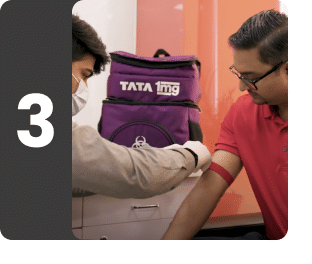Quadruple Marker with Graph - 2nd Trimester
Understanding Quadruple Marker with Graph - 2nd Trimester
What is Quadruple Marker with Graph - 2nd Trimester?
A Quadruple Marker with Graph - 2nd Trimester is the most common blood screening test done between the 15th and 22nd week (second trimester) of pregnancy to determine whether the baby is at risk for certain birth defects. It offers valuable information to ensure the well-being of both the mother and the unborn child.
Quadruple Marker with Graph - 2nd Trimester test is a prenatal screening test tailored to provide expectant parents with insights into the health of the developing baby. It analyzes specific markers in the mother’s blood to assess the risk of chromosomal abnormalities, such as Down Syndrome (Trisomy 21) and Edwards Syndrome (Trisomy 18), wherein extra copies of chromosome 21 and 18 are present and affect the baby's physical and intellectual development. It also screens for neural tube defects like spina bifida (a spinal cord defect) and anencephaly (a brain defect). These birth defects can result in nerve damage, learning disabilities, paralysis, or stillbirth.
The Quad in Quadruple Marker with Graph - 2nd Trimester test refers to the four specific markers measured in the mother’s blood during the screening. These include Alpha-fetoprotein (AFP), Human Chorionic Gonadotropin (hCG), Unconjugated Estriol (uE3), and Inhibin A. The levels of these markers when assessed collectively help in estimating the likelihood of certain fetal abnormalities that can affect the baby’s growth and development. Timely detection of these abnormalities is vital for ensuring comprehensive prenatal care and addressing potential health problems effectively. In addition to the traditional Quad marker analysis, the inclusion of a graphical representation enhances the interpretability of results.
A quad marker test is a screening test only and any abnormal result does not mean that the unborn baby has a birth defect or genetic condition. It only tells whether the unborn baby is at risk of developing certain abnormalities and further testing is required to confirm the diagnosis.
The decision to recommend the quad marker test is often based on maternal age, medical history, and individual risk factors for chromosomal abnormalities. Pregnant women should consult their doctor to determine the most appropriate screening or diagnostic test based on their specific circumstances.
No special preparation is required before undergoing a quad marker test. However, it is essential for a woman to be prepared to provide informed consent before undertaking this test. The laboratory personnel will explain the purpose, benefits, and limitations of this test.
Abnormal lab test results represent only the risk but not the diagnostic outcomes. Increased risk does not mean that the baby is affected, and further tests must be performed before a confirmed diagnosis can be made. Talk to your doctor about your specific test results.
What is Quadruple Marker with Graph - 2nd Trimester used for?
A Quadruple Marker with Graph - 2nd Trimester test is done:
-
To assess the risk of certain chromosomal abnormalities in the developing baby.
-
To detect the risk of Down Syndrome (Trisomy 21) in the developing baby.
-
To detect the risk of Edwards Syndrome (Trisomy 18) in the developing baby.
-
To detect the risk of neural tube defects like spina bifida in the developing baby.
-
Typically between the 15th and 22nd weeks of pregnancy, this offers a window for assessing specific developmental concerns in the developing baby.
What does Quadruple Marker with Graph - 2nd Trimester measure?
Contains 3 testsThe Quadruple Marker with Graph - 2nd Trimester test measures the levels of four specific markers in the blood of a pregnant woman. These markers are -Alpha-Fetoprotein (AFP), Human Chorionic Gonadotropin (hCG), Unconjugated Estriol, and Inhibin-A.
The analysis of these four markers along with other factors like maternal age, and gestational age, helps assess the risk of certain conditions in the developing baby. The graph in Quadruple Marker with Graph - 2nd Trimester provides a visual representation of the levels of these markers during pregnancy.
It is noteworthy that Quadruple Marker with Graph - 2nd Trimester is a screening test and any abnormal results may prompt further diagnostic testing for confirmation. Pregnant women should discuss their results and implications with their doctor.

Inhibin A
Inhibin A is a hormone produced by the placenta. Abnormal levels may suggest an increased risk of chromosomal abnormalities.
Know more about Inhibin A

HCG Beta Total Quantitative, Maternal
An HCG Beta Total Quantitative, Maternal test measures the levels of human chorionic gonadotropin (hCG) hormone in the blood. hCG is released in the blood during pregnancy and can be detected as early as 10 days after conception. The levels of this hormone gradually rise every 2 to 3 days (or 48 to 72 hours) and peak around 8 to 11 weeks after conception. After reaching the peak, the hCG levels decrease and remain steady for the rest of the pregnancy.
Know more about HCG Beta Total Quantitative, Maternal

Unconjugated Estriol
Unconjugated Estriol is a type of estrogen hormone produced by the placenta. Abnormal levels may suggest an increased risk of the developing baby being born with chromosomal abnormalities.
Know more about Unconjugated Estriol
Interpreting Quadruple Marker with Graph - 2nd Trimester results
Interpretations
|
Pregnancy Weeks |
AFP |
HCG |
Estriol |
Inhibin A |
|
14 |
27.20 ng/mL |
40370 mIU/mL |
0.37 ng/mL |
208.75 pg/mL |
|
15 |
32.01 ng/mL |
32200 mIU/mL |
0.55 ng/mL |
222.90 pg/mL |
|
16 |
37.67 ng/mL |
25690 mIU/mL |
0.76 ng/mL |
194.20 pg/mL |
|
17 |
44.33 ng/mL |
20490 mIU/mL |
1.00 ng/mL |
201.30 pg/mL |
|
18 |
52.16 ng/mL |
16340 mIU/mL |
1.25 ng/mL |
196.20 pg/mL |
|
19 |
61.38 ng/mL |
13040 mIU/mL |
1.50 ng/mL |
226.90 pg/mL |
|
20 |
72.33 ng/mL |
10400 mIU/mL |
1.76 ng/mL |
253.70 pg/mL |
|
21 |
85.08 ng/mL |
8295 mIU/mL |
1.99 ng/mL |
282.10 pg/mL |
|
22 |
100.02 ng/mL |
6620 mIU/mL |
2.30 ng/mL |
292.30 pg/mL |
|
Abnormality |
Cut off |
Detection rate |
False-positive rate |
|
Neural tube defects |
≥ 2.5 MoM (Multiples of median) |
70-75 % |
2-4 % |
|
Down Syndrome (Trisomy 21) |
1: 250 |
75 -80 % |
5 % |
|
Edwards Syndrome (Trisomy 18) |
1:100 |
60 % |
0.3 % |
Reference range may vary from lab to lab*
The base of screening tests is a statistical analysis of patient’s data which includes the demographic (statistical study of populations) and biochemical (laboratory) data.
Confirmation is mandatory by amniocentesis.
The results are illustrated in the form of a graph in the test report.
-
Positive quadruple marker test usually indicates that the unborn child has a high risk of neural tube defects and chromosomal disorders like Down's syndrome, Patau syndrome, etc. More specific tests like amniocentesis are then advised to make a definitive diagnosis
-
High levels of inhibin A usually indicate Down's syndrome whereas low levels might be associated with Edward's syndrome or trisomy 18. Sometimes, variable levels of inhibin A may also be present, and they are usually associated with trisomy 13 or Patau syndrome
Answers to Patient Concerns & Frequently Asked Questions (FAQs) about Quadruple Marker with Graph - 2nd Trimester
Frequently Asked Questions about Quadruple Marker with Graph - 2nd Trimester
Q. What is a Quadruple Marker with Graph - 2nd Trimester test, and why is it important?
Q. What tests are done in a quad marker test?
Q. When can I go for a quad marker test during my pregnancy?
Q. How is a quad marker test performed, and is it safe for the baby?
Q. What chromosomal abnormalities are screened by a quad marker test?
Q. Is quad marker test only advised for women of age 35 years or more?
Q. What is Down's syndrome?
Q. What is Edwards' syndrome?
Book Quadruple Marker with Graph - 2nd Trimester at-home





Other tests









